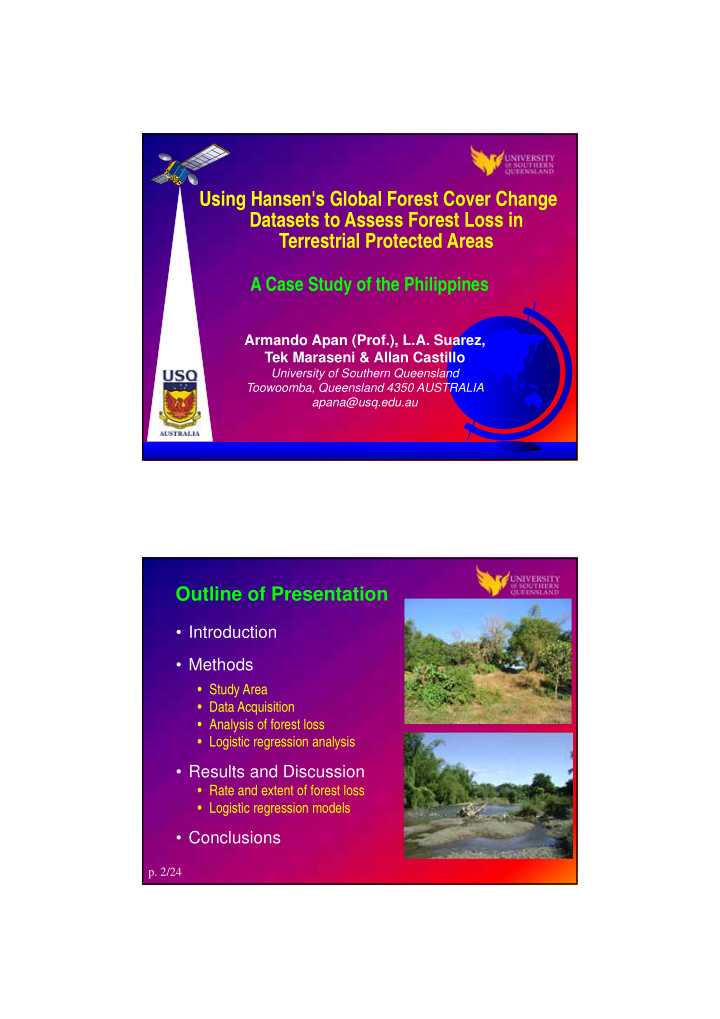



Using Hansen's Global Forest Cover Change Datasets to Assess Forest Loss in Terrestrial Protected Areas A Case Study of the Philippines Armando Apan (Prof.), L.A. Suarez, Tek Maraseni & Allan Castillo University of Southern Queensland Toowoomba, Queensland 4350 AUSTRALIA apana@usq.edu.au Outline of Presentation • Introduction • Methods • Study Area • Data Acquisition • Analysis of forest loss • Logistic regression analysis • Results and Discussion • Rate and extent of forest loss • Logistic regression models • Conclusions p. 2/24
… Introduction • Deforestation in the Philippines has been rampant and rapid. Forests 4 Climate • Forest cover has declined from 17.1 M ha (1937) to 8.0 M ha (2015) • Protected Areas are effective in reducing deforestation; some are not. JLR, 2010 • Need to understand the drivers of deforestation in protected areas. Sharif Mukul, 2016 p. 3/24 … Introduction This study assessed: • forest cover loss in all terrestrial protected areas (PAs) of the entire Philippines • covering 198 PAs with a total area of 4.68 million ha AFP/File, 2013 p. 4/24
… Introduction Objectives: 1. to compare the rate and extent of forest loss: • entire country vs. terrestrial Philippine EnviroNews protected areas vs. buffer areas 2. to determine the significance and magnitude of the relationships between forest cover and selected spatially explicit variables. p. 5/24 Methods Study Area • covers 298,170 km 2 • tropical climate • 101 million people (2016) • one of world’s top biodiversity-rich countries p. 6/24
… Methods Data Acquisition 1. “ Global Forest Change ” map (Hansen et al., 2013) • derived from Landsat imagery (30m) • analysis performed using Google Earth Engine (cloud platform) • Trees are defined as “ all vegetation taller than 5m in height ” • forest loss: “ a stand-replacement disturbance or the complete removal of tree cover canopy .” p. 7/24 … Methods Data Acquisition • used “time-series spectral metrics” as key algorithm • output layers: tree cover (2000); forest loss and gain (2000-2012) • reported accuracy of 99.6% • free download p. 8/24
… Methods Yearly Forest Cover Loss (2001-2012) p. 9/24 … Methods … Data Acquisition 2. “ World Database on Protected Areas ” (UNEP-WCMC, 2015) p. 10/24
… Methods … Data Acquisition • Land use (ISCGM, 2011) • Population Density (WorldPop, 2015) • Digital Elevation Model (SRTM) • Land Cover (NAMRIA, 2013) • Road (OpenStreetMap, 2015) • River (Lehner et al., 2006) p. 11/24 … Methods p. 12/24
… Methods p. 13/24 … Methods Data Processing & Analysis • Assess accuracy of forest cover map (2012) • Extract forest areas with >10% canopy cover • Intersect with “Forest Cover Loss” maps • Intersect with “Protected Areas” map p. 14/24
… Methods Data Processing & Analysis Logistic Regression • estimated the probability of deforestation occurrence • modelled the relationship between: • independent variables (11 maps) • dependent variable (“ no forest loss ”, “ forest loss ”) • used Spearman's rho to assess any multi-collinearity issues p. 15/24 Results and Discussion • Overall Accuracy of Hansen dataset (2012) : 93.1% • Rate of forest loss in protected areas (vs. entire Philippines) is marginally lower Protected Parameter Philippines Area Total Forest Loss by 2012 (ha) 529,675 97,007 Average Forest Loss (ha/yr) over 12 years 44,140 8,084 Rate of Forest Loss (%) over 12 years 2.69% 2.59% • But it is equivalent to a total of 3,738 ha over 12 years p. 16/24
… Results and Discussion Annual and cumulative forest loss in the Philippines p. 17/24 … Results and Discussion • Inside PAs forest loss rate was lower (1.87%) vs. 2-km buffer (2.63%). • Forest loss in buffer zones is 1.4 times (40.6%) higher than the PAs. p. 18/24
… Results and Discussion • But some PAs have phenomenal forest loss rates (e.g. 21%) Cumulative Cumulative Forest Area Protected Area Forest Loss Forest Loss (ha) Area (ha) Rate (%) Magapit 2,753 578 20.98% Angat 6,317 660 10.45% 643 56 8.65% Fuyot Springs Dinadiawan River 3,267 277 8.47% Sohoton 419 31 7.44% p. 19/24 … Results and Discussion • Some areas with vast areas of forest loss (e.g. 48,583 ha) Cumulative Cumulative Forest Area Protected Area Forest Loss Forest Loss (ha) (2000) Area (ha) Rate (%) 48,583 980,537 4.95% Palawan 12,340 442,095 2.79% Samar Quirino 5,985 159,160 3.76% Unnamed NP 3,531 120,590 2.93% 2,880 274,905 1.05% Northern S. Madre p. 20/24
… Results and Discussion • Spatial predictor variables have no or weak relationships with forest cover loss. Spearman Variables Correlation (vs. Forest Loss) Elevation -0.305 Distance from cropping area -0.220 Population density 0.179 Distance from road -0.170 Distance from closed canopy forest 0.163 Slope -0.137 Distance from open canopy forest 0.093 Land cover -0.055 Land use -0.033 Distance from river -0.029 Aspect -0.023 p. 21/24 … Results and Discussion • Model fit and classification accuracies were not good , with only 15% of the variance explained. Model % Correct Baseline, intercept-only (no 50.0 regression model applied) Socio-economic variables only 58.9 Proximity variables only 61.1 Topographic variables only 62.9 All variables included 64.9 Only 15% improvement p. 22/24
Conclusions • Global Forest Cover Change datasets: useful for the country-wide assessment of forest loss. • Protected areas are generally effective in reducing deforestation. • However, some areas indicate the ineffectiveness of PAs . • Selected variables are not reliable for predictive modelling of forest loss. p. 23/24 THANK YOU!
Recommend
More recommend